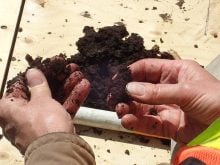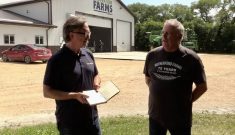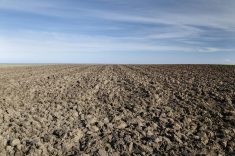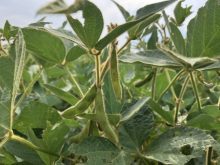Glacier FarmMedia – Being a pioneer isn’t easy, but sometimes it can pay off. Or at least that’s what John Kolk hopes.
Over the past few years, the southern Alberta farmer has been using strip tillage on row crops such as dry beans, corn and soybeans. Although the system hasn’t been a big earner in terms of dollars and cents, Kolk is sticking with it for the long-term health of his soil.
The targeted tillage practice has been tagged as a best-of-both-worlds approach between conventional production and no-till, and Manitoba research gives some credence to its potential for warmer seed beds and moisture management in row crops.
Read Also

Time to be honest about hemp, experts say
Years of hype have given way to a more realistic view of hemp. Farmers and processors say the crop’s future depends on solid agronomy, honesty.
“The less disturbance, the less loss of soil biodiversity under the ground,” Kolk said.
“[Strip-till] allows you to leave green roots until your new seedlings are started on at least 60 per cent of your land. You’re giving space for the underground moving creatures like soil mites to have an area that’s not disturbed. I think it’ll help soil health over time because tillage is pretty harsh on soil health.”
A downside is that the practice, though becoming more popular in regions of the U.S., is practically unheard of in Alberta. That means little equipment support, and a lot of trial and error.
“You don’t have the service people so it’s a little bit of a stretch to try it here,” said Kolk. “We checked around and there were only two people we found in southern Alberta that were doing any strip tillage or some iteration of it.
“As in most changes in management, it takes a while to make it work. You’ve got to grit your teeth and work your way through it.”
Middle ground
Strip-till could be considered the middle ground between the soil-warming and drying effects of conventional tillage and the soil-protecting advantages of zero-till. Using special equipment, it disturbs soil only in the inches-wide strips that contain the seed row.
In Manitoba, the practice has gotten interest from researchers—largely as a fall field-work method—as a way to bolster long-season crops with high tillage.
In a 2020 episode of the University of Manitoba’s MAKE podcast, now retired crop nutrition specialist John Heard pointed to strip tillage for crops like corn, edible beans, soybeans and sunflowers—anything that is typically seeded with a wide-row planter.
“Zero-till can work very well for some traditional Prairie crops—cereals that thrive under cool conditions, oilseeds like canola and flax and pulse crops like peas—but those are not the crops that are being targeted for strip till,” he said.
“Strip till, they’re the warm season crops that we’re shoving into and trying to grow in a cool Prairie environment.”

The university uses its MAKE platform to disseminate research highlights and farmer resources.
The same podcast highlighted work by University of Manitoba agronomy and cropping systems researcher Yvonne Lawley.
That on-farm research had a few noticeable takeaways.
When looking at the previous year’s corn field, seed beds prepped with strip tillage had more heat during day-time highs in the afternoon, even compared with conventional or vertical tillage. Lawley suggested this might be linked to the soil berm left from strip tillage that catches more sunlight. There was less temperature difference in the morning.
Her research found drier soil beds “in some years, at some sites,” Lawley said during the podcast.
In contrast, areas between the tillage rows conserved moisture during dry years, she noted.
She pointed to 2018 and 2019, when Manitoba’s soybean crops did not get needed late-season rains.
“This might be a system that, especially if we compare it to conventional tillage, we can get some drying in the springtime, and then some conservation of moisture later in the season,” she told the interviewer at the time.
Heard also noted the possibility of combining strip tillage with targeted fertilizer delivered to the seed row.
Strip-till in canola?
Over in Alberta’s Palliser Triangle, Kolk was looking for something that could help protect his crops from wind erosion while disturbing his soil as little as possible. He wondered if strip tillage might prepare the soil for seed canola as well as row crops such as dry beans and corn.
“We tend to have fairly dry soil and high winds,” he said. “We’re on white soil, which is kind of a sandy loam. With small-seeded crops like canola or dry beans, if you get a bad wind and the plant’s just out of the ground, the soil starts moving and cuts the little plants off. I was looking for a solution that would reduce the wind right at the surface.
“With wheat and barley, you can leave stubble because you can seed direct, but with the row crops we don’t have that option.”
The equipment
Kolk uses a special strip-till unit to work only the six inches where the seed goes in. The process leaves 14 inches of undisturbed stubble between strips.
One of the biggest challenges is weed control.
“The one thing about tillage is there are no weeds that are resistant to tillage,” said Kolk. “So if you’re not tilling, of course you have to figure out what kind of chemistry to use and that’s not always easy with multiple crops.”
The equipment can also present a challenge, he said.
“We have a tillage bar that we put the strip-till units on. Strip-till units tend to look a little bit complicated; they basically have a front cutter wheel to cut the trash and then — in our case — we have a shank that goes down about six inches behind that and it’s got two protecting disks to keep the dirt from flying out too far on both sides of it.”
The Alberta producer first tried the unit on corn.
Using it for spring seedbed prep, Kolk noted that field operations were late that year, and he lost germination when seed was rushed in soon after the strip-till treatment, into soil that did not facilitate good seed-to-soil contact.
The next few years were filled with trial and error and gradually increasing confidence.
“I thought we had it down last year, and then we had a year where some of the chemistries weren’t controlling the weeds,” said Kolk. “So we’re going to make a few changes on that. Depending on the year, we might try a spring cover crop on some of the later-seeded beans and see if that works.
“I would say we’re 80 per cent there, but to make it really work well and with confidence, I think we need to learn a few more things and make a few more changes.”
Kolk is playing the long game when it comes to strip-till. Although he’s seen some efficiencies in diesel use, it hasn’t been a “big win” in terms of yield advantage.
“Two years ago we had a few crops that were probably ahead of the game. Last year we were probably a little behind or average,” he said.
“I can’t call it an absolute win yet. Right now it’s additional costs without necessarily any financial benefit. I’m hoping that a little bit of soil health benefit will certainly reduce wind erosion in a major way.”
Still, Kolk figures it’s only a matter of time — and effort — before strip-till becomes more common.
“I think over time if we can cure some of the issues around weed control and get some people who know how to service these units and set them and whatnot, I think you’ll see more of it in the special crops area.”
– With files from Alexis Stockford. This article was originally published at the Alberta Farmer Express.
















